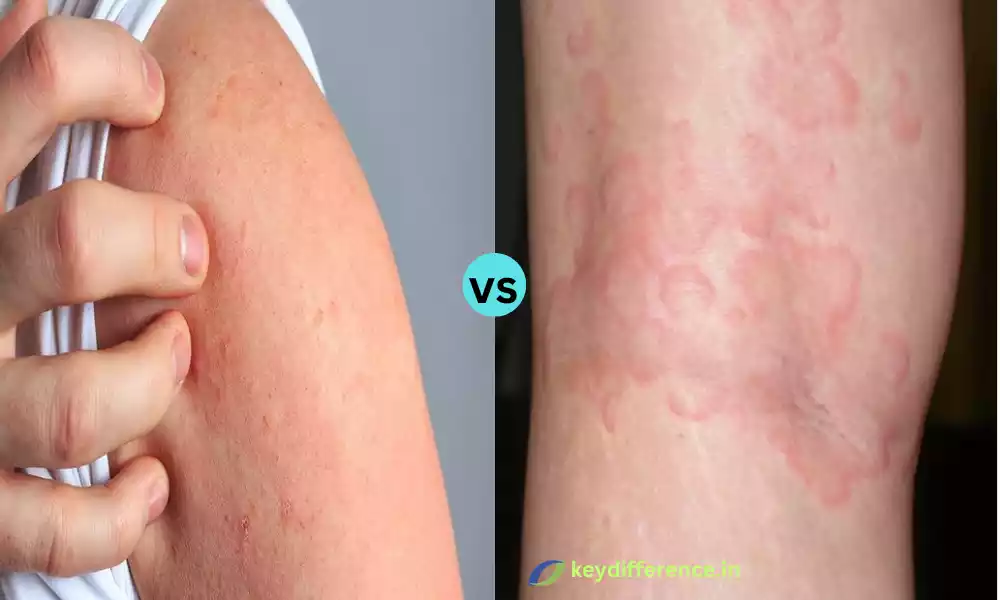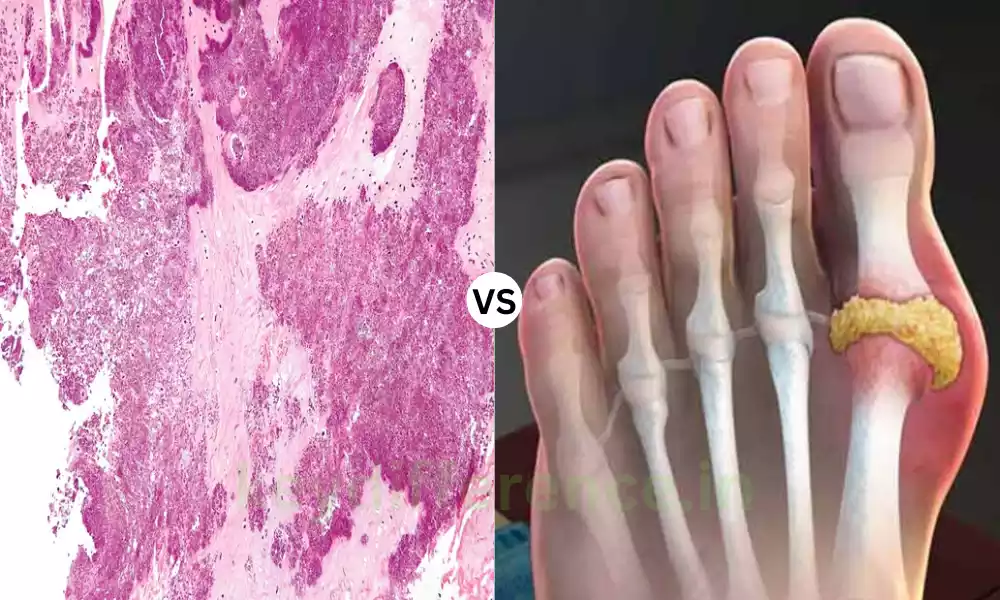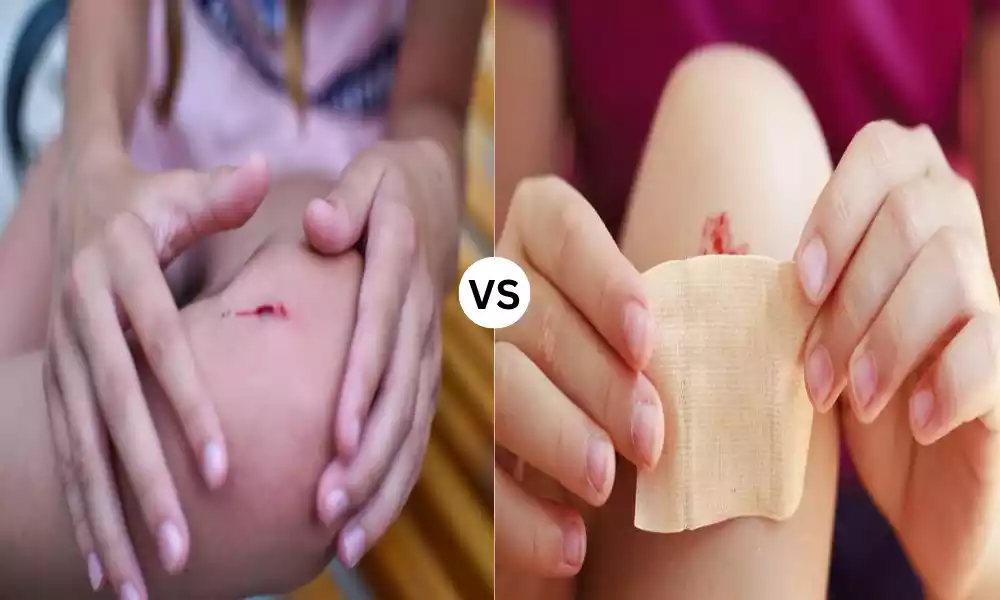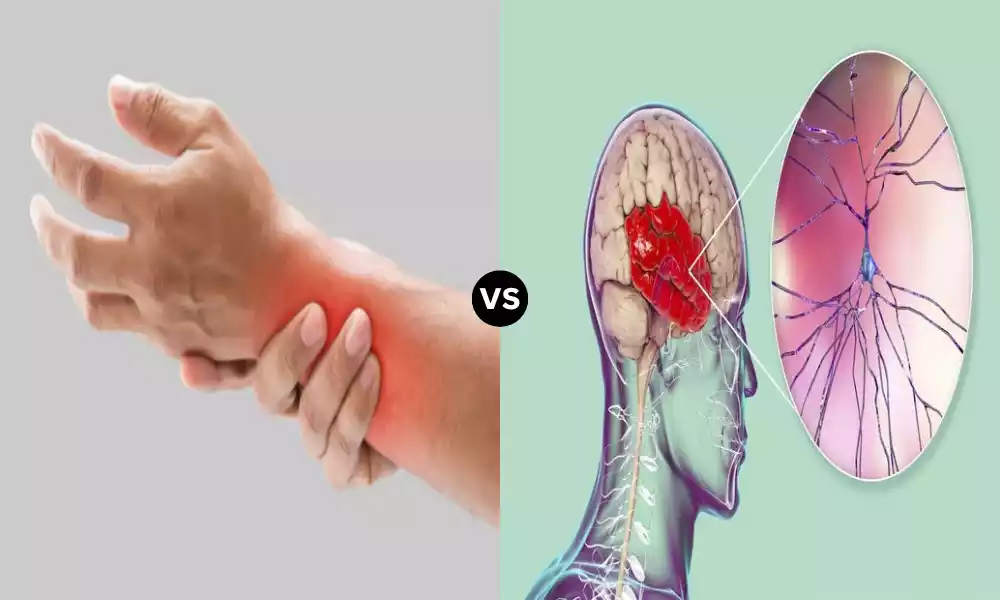Urticaria and scabies are two separate skin conditions that each have their own symptoms, causes, and treatment. It is essential to differentiate between the two since they require different methods of treatment and care. We’ll explore the key distinctions between urticaria and scabies starting from their causes and clinical manifestation to diagnosis and treatment to help you comprehend and differentiate between these two skin diseases.
Definition of Scabies
Scabies is a virulent skin condition resulting from small mites referred to by the name Sarcoptes scabiei. These tiny parasites penetrate the upper layer of the skin and produce eggs, causing reactions that are allergic.
This can cause discomfort and an itchy pimple-like rash that is characterized by bumps blisters, sores, or abrasions. Scabies typically are spread by contact with skin that is close and may affect people of any age. An accurate diagnosis and treatment is vital to get rid of the scabies mites and relieve symptoms.

Definition of Urticaria
Urticaria also known as hives is a skin disorder that is characterized by the abrupt appearance of itchy, red, and, often, pink or red wheals or welts that appear in the face. These welts differ in size and shape and can appear or disappear quickly.
Urticaria is usually due to an immune system reaction that is often caused by stress, allergens medications, or any other triggers. It is thought to be an allergic reaction that may manifest anywhere in the body. Urticaria may be acute, lasting from a few minutes to several weeks, or chronic, lasting for a minimum of six weeks.
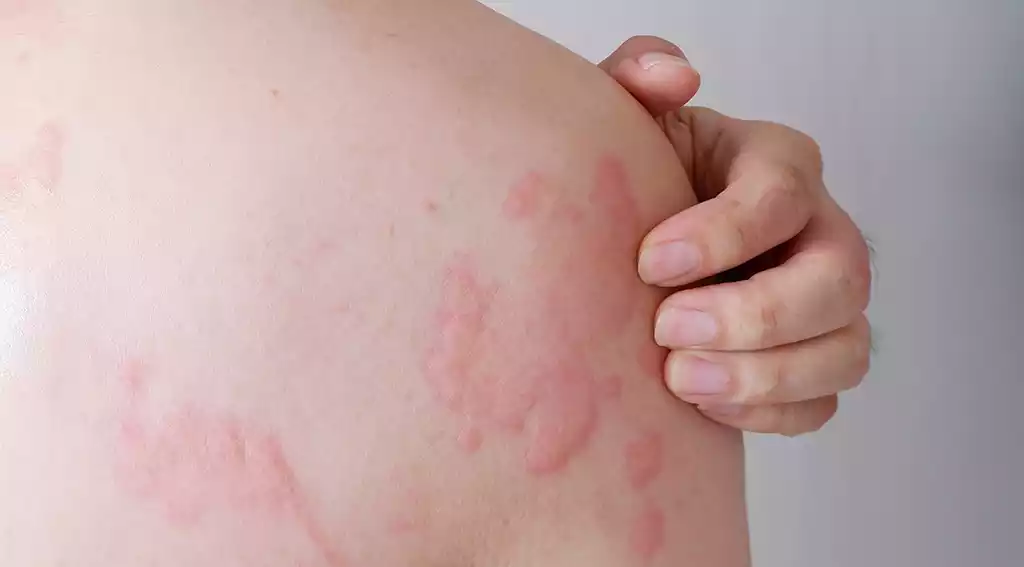
Comparison Table of Scabies and Urticaria
Here’s a comparison table highlighting the key differences between Scabies and Urticaria:
| Characteristic | Scabies | Urticaria |
|---|---|---|
| Definition | Contagious skin infestation caused by Sarcoptes scabies mites burrowing into the skin. | A skin condition characterized by raised, red, itchy welts or hives often triggered by allergens. |
| Causes | Infestation by mites; direct skin-to-skin contact with an infected person. | Immunological response is often triggered by allergens, stress, or medications. |
| Clinical Presentation | Itchy rash, pimple-like bumps, sores, or blisters; often in webbed areas between fingers, wrists, armpits, etc. | Raised, red, or pink welts (hives) that vary in size and shape and may come and go rapidly. |
| Diagnosis | Clinical examination; skin scrapings for mite identification. | Clinical examination; allergy testing for suspected triggers. |
| Treatment | Topical creams or lotions (e.g., permethrin); oral medications in severe cases; cleaning and disinfecting personal items. | Antihistamines to relieve itching; identifying and avoiding triggers; corticosteroids for severe cases. |
| Contagiousness | Highly contagious through direct skin-to-skin contact. | Not contagious; it’s an allergic reaction, not an infestation. |
| Prognosis | Curable with treatment; may recur if not all mites are eliminated. | Often temporary and manageable with medications; chronic urticaria can persist. |
| Prevention | Avoid close contact with infected individuals; launder bedding and clothing of infected persons. | Identify and avoid triggers; manage underlying allergies if necessary. |
This table provides a concise overview of the main distinctions between scabies and urticaria, including their definitions, causes, clinical presentations, diagnostic approaches, treatments, contagiousness, prognosis, and prevention strategies.
Importance of distinguishing between Scabies and Urticaria
The distinction between urticaria and scabies is vital for a variety of reasons:
- appropriate treatment: Urticaria and Scabies require different approaches to treatment. Scabies are a result of mites and are treated with medications that treat scabicidal infections, while Urticaria, which is an allergic reaction is a reaction to antihistamines and the avoidance of allergens. Undiagnosed or improper treatment may cause chronic discomfort and even the spread of Scabies.
- The risk of spreading: The scabies virus is extremely infectious through direct skin-to-skin contact. Failure to detect and identify Scabies cases could lead to outbreaks in close contact. Urticaria On the contrary isn’t contagious it’s an immune reaction to a variety of triggers.
- Public Health Risk: Scabies outbreaks in institutions such as schools, prisons, nursing homes or nursing homes could have serious negative health effects for the general public. The prompt diagnosis and timely treatment for scabies patients are vital to avoid spreading in these environments.
- Chronic Condition: Urticaria can be chronic or acute and may last for up to six weeks. The distinction between the two types of conditions aids in determining the best treatment plan for each for chronic urticaria, since it may require continuous treatment and surveillance.
- Beware of unnecessary medications: Misdiagnosing urticaria as scabies may lead to excessive treatment with scabicidal medications that may cause side effects and may contribute to the development of drug-resistant forms of scabies.
- patient comfort: The two conditions could result in significant discomfort and itching, however, the treatment methods differ. An accurate diagnosis can ensure that patients receive the best treatment for their discomfort quickly.
- Prevention of Reinfestation: A proper diagnosis and treatment for Scabies are crucial to avoid reinfestation in individuals as well as their contact with them. The inability to distinguish Urticaria from scabies could cause ongoing infections.
Recognizing the two is essential to ensure proper treatment, prevent the spread of infectious scabies as well as address public health concerns manage chronic illnesses efficiently, stay clear of unnecessary medication improve the comfort of patients, and stop reinfestations.
An accurate diagnosis is vital to providing the best treatment for those suffering from these skin diseases.
Clinical examination by a dermatologist
The dermatologist’s examination is a crucial method of diagnosing a variety of skin disorders, such as urticaria and scabies. The following is how a dermatologist normally conducts a medical examination for each of the conditions:
Clinical Examination for Scabies:
- Patient Background: The dermatologist begins by taking a thorough medical history that includes details regarding the patient’s symptoms as well as the duration of symptoms, as well as all recent contacts with affected individuals.
- Physical Exam: The dermatologist examines the skin area affected with great care. They might make use of a magnifying lens or dermatoscope to examine the skin thoroughly.
- Recognition of Scabies Burrows: The most important diagnostic characteristic of Scabies is the detection of tunnels and burrows constructed by mites. They are usually small, irregular, raised lines that are grayish or flesh-colored. They’re typically seen in webbed areas between wrists, fingers, and elbows, as well as armpits, the breasts (in women) Genitals, breasts (in men), and buttocks.
- skin scraping: Sometimes dermatologists can perform the procedure of skin scraping. A scalpel blade or edges of glass slides are employed to collect a small portion of the skin from the area affected. This is then examined under microscopes to determine that there are no mites or their eggs.
- Examining other family members or close Kontakts: As scabies have been proven to be extremely contagious, a dermatologist might suggest examining and treating family members or close friends even if they’re not symptomatic.
Clinical Examination for Urticaria:
- Patient Background: Similar to scabies dermatologists begin by taking a thorough medical history. They will ask about the first sign of hives and previous exposures to triggers, as well as the existence of any associated symptoms, such as swelling or itching.
- Physical Exam: The dermatologist examines the patient’s skin to evaluate the appearance and spread of Hives. They search for raised, pink, or red welts that could differ in size and shape.
- Provocation testing: In some cases of chronic urticaria, or when the reason for the urticaria is not clear the dermatologist can conduct provocation testing. The procedure involves applying the skin to potential triggers such as temperatures or cold to see whether hives begin to develop.
- Tests for Allergies: In the event of suspicion that an allergen trigger has been identified, a dermatologist might suggest testing for allergies for example, skin test or blood tests to determine the specific allergens responsible for the urticarial reaction.
A clinical exam conducted by dermatologists is vital to accurately diagnose and separate between urticaria and scabies. It helps in the identification of the most characteristic symptoms and signs which can lead to the most appropriate treatments and strategies for each condition.
Allergy testing if suspected triggers
“Allergy testing if suspected triggers” is an approach to diagnosis that is used by health professionals, such as allergists and dermatologists, to find specific allergens that could be causing reactions to allergies, such as ailments such as Urticaria (hives).
This is a brief overview of the process of testing for allergies and the way it’s conducted:
Types of Allergy Testing:
- The Skin Prick Test: One of the more frequently used allergy tests. The procedure involves applying a tiny dose of extracts from allergens onto the skin, primarily on the back or forearm. A small lancet or needle is employed to poke or scratch the skin, which allows the allergen to pass through just below the skin’s surface.If someone is allergic to the particular allergen the reaction will be localized with the appearance of tiny bumps (wheal) and the appearance of redness (flare) can occur in around 15 to 20 minutes.
- blood tests (Specific IgE): Blood tests are able to measure the amount of certain antibodies (IgE) created in the immune system when it reacts to allergens. The results show the presence and amount of IgE antibodies towards specific allergens. Blood tests that are commonly performed include ImmunoCAP or RAST.
- Tests for Patches: Patch testing is usually used to determine the triggers of contact dermatitis. It is a kind of skin rash that is caused by close contact with allergens.A small amount of allergens is put on the patches that are then put directly on your skin (usually on the back) for a period of 48 days. The dermatologist examines the skin’s reaction following the time.
When Allergy Testing is Used for Urticaria:
Allergy testing can be considered when allergens are suspected to trigger symptoms of chronic Urticaria (hives that last for more than six weeks). The test includes:
- Diagnostic Assessment: A dermatologist initially conducts a thorough medical assessment that takes into consideration the medical history of the patient as well as any symptoms and suspected triggers. When there’s a solid indication that allergens are the reason for the symptoms, it is suggested to test.
- Testing Selection: On the basis of suspect allergens (e.g. certain substances, foods insects, insect stings, or environmental elements) The dermatologist chooses the most appropriate allergy testing.
- Testing Procedure: The chosen test (skin Prick test or the blood test) is used to determine particular allergens that cause the urticarial reaction.
- Definition: The results of the allergy test can identify or exclude particular allergens as triggers for the symptoms of urticaria.
- Treating and Preventing: allergens that cause specific reactions are identified, patients will be able to take steps to avoid triggers and treatment could be altered to suit. This may include allergen avoidance strategies, including diet changes or medication adjustments.
It is important to remember that there are many instances of urticaria that can be triggered by allergies. The non-allergic cause, such as the stress of life or other medical conditions, may also trigger Urticarial reactions.
Thus, a thorough evaluation that includes a clinical exam and, if needed allergy testing can be used to identify the root cause of the problem and create an effective treatment plan for people suffering from the condition.
Launder bedding and clothing of infected persons
Washing the bedding and clothes of those suffering from the disease is a vital step in stopping the spread of Scabies. Scabies are a contagious skin condition due to the Sarcoptes scabiei scabiei fungus, and the mites can live on bedding, clothing, and other textiles for a brief period of time.
Here’s how to wash these objects:
Bedding and Clothing Laundering Steps for Scabies:
- Take in affected items: Collect all bedding clothes, bedding, and personal items that came into contact with the affected person. This includes pillows, sheets towels, blankets clothes, and anything else which have been utilized or worn with close contact.
- Separate items: Keep the infested items apart from other laundry items to avoid contamination. Utilize a plastic bag or laundry basket specifically designed for the items infested.
- Wash with hot Water: Use a washing machine to wash the items that are infested. Clean them using hot water (at minimum 120degF or 50degC) to eliminate the mites and their eggs efficiently. Hot water is the most effective method to eliminate scabies-causing mites from clothing.
- Use detergent: Add a regular laundry detergent to the wash cycle. Detergents are used to remove oils, dirt, and mites from fabric.
- Dry at High Heat: After washing, move the laundry items into dryers and dry them at the highest setting. The heat will eliminate the remaining mites. It is crucial to thoroughly dry the item because humidity may encourage the growth of the mite.
- Store Separately: When the items are dry and clean put them in a separate storage area from items that aren’t infested, to prevent the possibility of re-infestation.
- Cleaning Personal Products: Personal items such as brushes, combs, and other grooming equipment should be thoroughly cleaned or disinfected.
- Vacuuming: the living area as well as furniture where the person infected has been in a position of sitting, lying, or lying. Get rid of the bag of vacuum cleaners or cleanse the vacuum thoroughly to get rid of any possible allergens.
- Be sure to notify close contacts: If you reside in close proximity with an infected person It is essential to inform them in order to be aware of the risk and seek medical assistance should they need it.
- Be Prepared for Treatment: Alongside washing items, the affected person and their close friends should adhere to the treatment protocol suggested by a medical expert. This usually includes applying scabicide creams or lotions.
Cleaning your bedding and clothing properly is a crucial aspect of the overall treatment of scabies. It can also help in preventing its spread to other people within the family or in the community.
If you suspect that you have scabies, or have had contact with an affected person seek out a medical professional to determine the proper diagnosis and treatment strategy.
What are the Similarities Between Scabies and Urticaria?
Urticaria and scabies both are distinct conditions of the skin, each with distinct causes and pathophysiological processes.
There are, however, certain similarities between the two conditions:
- Skin Signs and symptoms: Both scabies and Urticaria may cause discomfort and itching. People who suffer from these conditions usually have itchy skin, which may range from mild to severe and could significantly impact their lives.
- Visual Skin Variations Both: situations can lead to noticeable skin changes. For scabies this may include visible pimple-like bumps blisters or sores and in the case of urticaria, this is the appearance of raised, pink, or red skin welts (hives) in the face.
- Itching: Itching or pruritus is a typical manifestation of both scabies and Urticaria. Itching can be extremely intense and bothersome in both conditions, which can lead to pain and an overwhelming need to scratch at the areas affected.
- The possibility of allergic reactions: While the underlying causes differ Both conditions may have an allergy component. In scabies, the body’s response to proteins from mites can result in reactions that are allergic. Urticaria is a condition where it is the release of histamines in the course of the immune response could trigger an allergic reaction.
- Both can be managed: Both scabies and Urticaria are manageable and effectively treated by medical intervention. Treatment strategies may differ between these two conditions, however, both provide alleviation from the symptoms and enhance the living quality of those affected.
- Impact on Quality of Life: The discomfort and itching that is caused by both scabies, as well as Urticaria, can seriously affect the quality of life for a person. In extreme cases, they could interfere with sleeping, daily activities, and overall health.
It’s crucial to understand that despite these similarities the two conditions have different reasons, diagnostic criteria treatments, and contagiousness profile. A precise diagnosis by a healthcare expert is crucial in determining the best treatment for each condition.
Reference Books
Certainly, here are some reference books related to dermatology and skin conditions, including scabies and urticaria, that can provide in-depth information and insights into these topics:
- Fitzpatrick’s Dermatology in General Medicine by Thomas B. Fitzpatrick, et al.
- This comprehensive dermatology textbook covers a wide range of skin conditions, including in-depth discussions on their causes, pathophysiology, clinical presentations, diagnosis, and treatment.
- Dermatology Essentials by Jean L. Bolognia, et al.
- A concise yet comprehensive resource for dermatology, this book provides practical information on various skin disorders, their diagnosis, and treatment options.
- Hurwitz Clinical Pediatric Dermatology: A Textbook of Skin Disorders of Childhood and Adolescence by Amy S. Paller and Anthony J. Mancini.
- Focusing on pediatric dermatology, this reference book offers insights into skin conditions commonly seen in children and adolescents, including those related to allergies and infectious diseases.
- Ferri’s Clinical Advisor 2022: 5 Books in 1 by Fred F. Ferri.
- While not exclusively a dermatology textbook, this medical reference book covers a wide range of medical topics, including dermatological conditions. It provides concise overviews and treatment guidelines for various skin disorders.
- Dermatology: Illustrated Study Guide and Comprehensive Board Review by Sima Jain.
- Designed as a study guide, this book helps medical students and professionals prepare for dermatology board exams. It offers a structured approach to understanding dermatological conditions.
Conclusion
Knowing the difference between urticaria and scabies is vital for accurate diagnosis as well as proper treatment. Although these skin conditions have certain similarities, like itching and visible changes to the skin, however, their causes, diagnostic procedures, and treatment strategies differ.
A proper diagnosis by medical professionals is crucial in order to offer effective treatment and avoid any future problems. If you suspect any of these issues consulting a doctor is the best option to ensure proper assessment and treatment.

